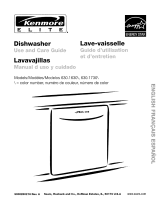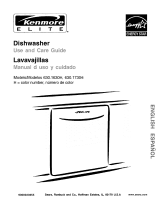
18
Self Help
Dishwashers may occasionally exhibit problems that are unrelated to a malfunction of the dishwasher
itself. The following information may help you with a dishwasher problem without involving a repair
professional.
Problem Cause Action
Dishwasher
does not start
1. Door may not be properly latched
2. Unit may not be turned on
3. Unit not reset or previous cycle not com-
pleted
4. Delay start engaged
5. Interruption of electrical power supply to
dishwasher or blown fuse.
6. The door may have been closed without
first selecting a cycle
7. Water supply may not be turned on
1. Shut the door completely
2. Press the main power switch to turn unit on
3. To reset, refer to “Cancelling a Cycle” in this manual
4. To reset, refer to “Delay Start” section in this manual
5. Check circuit breaker
6. Select a cycle and close the door.
7. Check and turn on water supply
Dishwasher
beeping (end
of cycle sig-
nal)
1. Default factory settings alert the customer
that the cycle is complete by beeping. This
feature can be deactivated if so desired.
1. To adjust the volume or deactivate, refer to the “cycle
completion signal” section in this manual.
Display does
not illuminate
or console
lights are not
on
1. A fuse may have been blown or circuit
breaker tripped
2. Door not closed or latched
Note: For models with controls on top of the
door, the display only illuminate when the
door is opened and controls are visible.
1. Check the fuse or circuit breaker box and replace the
fuse or reset the breaker if necessary
2. Ensure door is properly latched and completely closed
Dishwasher
seems to run
a long time
1. Incoming water is not warm enough
2. Cycle time can vary due to soil and water
conditions
3. Rinse agent dispenser is empty
4. Dishwasher connected to cold water sup-
ply
Note: Refer to “wash cycle information” sec-
tion in this manual for typical cycle lengths
1. Before starting a cycle, run hot water faucet at the sink
closest to the dishwasher
2. Sensors in the dishwasher automatically increase the
cycle time to ensure a good wash when heavy soil is
detected
3. Add rinse agent
4. Verify dishwasher is connected to hot water supply
plumbing
Dishes are not
getting clean
enough
1. Spray arm movement obstructed
2. Spray arm nozzles clogged
3. Improper use of detergents
4. Filters could be clogged
5. Dishes are nested or loaded too close
together
6. Selected wash cycle is not suitable for
food soil conditions
1. Ensure that spray arm movement is not blocked by
hand rotating spray arms before starting cycle
2. Remove the spray arms and clean according to the
“care and maintenance” section of the manual
3. Increase or decrease detergent depending on the water
hardness (refer to Table 1)
4. Clean the filters according to the “care and mainte-
nance” section of the manual
5. Rearrange load such that water spray can reach all
items in the dishwasher - see “loading the dishwasher”
section of the manual
6. Refer to “wash cycle information” section of the man-
ual
Dishes are not
getting dry
enough
1. Rinse agent dispenser is empty
2. Improper loading of dishes
3. Selected cycle does not include drying
Note: Plastic or Teflon do not typically dry as
well as other items due to their inherent
properties
1. Add rinse agent - the use of rinse agent improves dry-
ing
2. Rearrange load to ensure items are not nesting (see
“loading the dishwasher” section of the manual)
3. Rinse and Hold setting does not include drying
Note: Select models offer an extra heating option to
improve drying performance.





















